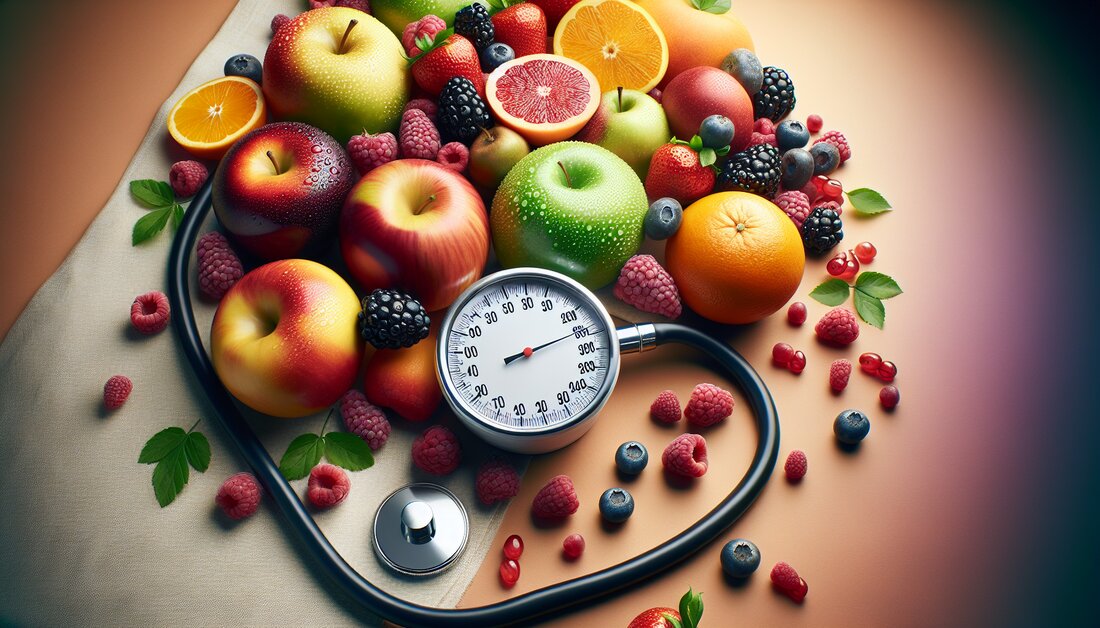Fructose and blood pressure: The influence of food intake
Study shows: Fructose affects blood pressure differently depending on the source and energy content! Vs. #health #nutrition

Fructose and blood pressure: The influence of food intake
Recent scientific research, published in 2023, examined the influence of fructose-containing sugars on blood pressure (BP). Fructose, also known as fructose, is found in many foods we consume regularly, from fruit to sugary drinks. What makes this study special is the detailed look at how different sources of fructose sugars, coupled with different levels of energy control, might affect blood pressure.
The research distinguishes between four types of study designs: replacement (equal energy substitution of sugars), addition (additional energy from sugars added), subtraction (excess energy from sugars removed) and ad libitum (energy from sugars freely replaced). The key results showed that fructose-containing sugars reduced systolic and diastolic blood pressure in addition experiments in which additional energy was added through sugar. Interestingly, the source type of sugar had a significant impact: fruit and 100% fruit juice led to a small but important reduction in blood pressure, while mixed sources (with sugary drinks) increased blood pressure.
The study results suggest that the source of fructose sugar and control over the level of absorption may be crucial. Consuming fruits and 100% fruit juice in moderate amounts can slightly lower blood pressure, while excessive consumption of sugary drinks or mixed sources can increase blood pressure.
These findings could have far-reaching implications for public health recommendations and individual dietary habits. When it comes to managing or controlling blood pressure, these findings could prompt doctors and nutritionists to offer more specific advice on choosing foods containing fructose - especially for people with high blood pressure or at high risk of it.
Basic terms and concepts:
- Fruktose: Eine Form von Zucker, die in vielen Lebensmitteln, insbesondere in Früchten, natürlich vorkommt.
- Blutdruck (BP): Die Kraft, mit der das Blut gegen die Wände der Blutgefäße drückt, während es durch den Körper zirkuliert.
- Systolischer Blutdruck: Der höchste Druck in den Blutgefäßen, der auftritt, wenn das Herz schlägt.
- Diastolischer Blutdruck: Der niedrigste Druck in den Blutgefäßen, der zwischen den Herzschlägen auftritt.
- Zuckerhaltige Getränke (SSBs): Getränke mit zusätzlichem Zucker, wie Limonaden, einige Fruchtsäfte, Energydrinks usw.
- Energiekontrolle: Die Regulierung der aufgenommenen oder entfernten Kalorienmenge aus der Ernährung.
Influence of fructose-containing sugars on blood pressure depending on energy control and food source
The role of fructose-containing sugars in the diet and their influence on blood pressure (BP) was examined through a systematic review and meta-analysis to clarify to what extent the food source or energy content mediates the effect on blood pressure. The study analyzed controlled trials that lasted longer than 7 days and were published in the MEDLINE, Embase and Cochrane Library databases up to June 2021.
Study design and methodology
The meta-analysis specified four study designs based on energy control:
- Substitution (energiegleicher Ersatz von Zuckern)
- Addition (überschüssige Energie durch zusätzliche Zucker)
- Subtraktion (Entfernung von überschüssiger Energie durch Zucker)
- Ad libitum (Energie aus Zuckern wird nach Belieben ersetzt)
The primary endpoints were systolic and diastolic blood pressure. Data extraction was performed by independent reviewers, while the certainty of evidence was assessed via GRADE.
Results
A total of 93 reports (with 147 experimental comparators, N = 5,213) were included that examined 12 different dietary sources of fructose-containing sugars across the four levels of energy control in adults with and without hypertension or at risk of hypertension. Fructose-containing sugars had no effect in substitution, subtraction, or ad libitum trials, but resulted in a decrease in systolic and diastolic blood pressure in addition trials (P<0.05).
Analysis of the interaction by food source revealed significant differences: fruit and 100% fruit juice lowered blood pressure in addition trials, while mixed sources (with sugary drinks) increased it. Removal of sugary drinks or mixed sources resulted in a reduction in blood pressure in subtraction trials. The certainty of the evidence was generally rated as moderate.
conclusion
The study shows that food source and control of energy intake mediate the effect of fructose-containing sugars on blood pressure. In particular, fruit preservation and pure fruit juice in low doses (up to or less than the public health limit of ~10% E) resulted in small but important reductions in blood pressure. The addition of excess energy from mixed sources (with sugary drinks) in high doses (up to 23%) resulted in moderate increases, its removal or the removal of sugary drinks alone (up to ~20%E) in small but important decreases in blood pressure in adults with and without hypertension or at risk of hypertension.
These results highlight the importance of food source and energy management in the effect of fructose-containing sugars on blood pressure and provide an important starting point for public health recommendations and individual nutritional strategies for the prevention and treatment of hypertension.
The study is registered at Clinicaltrials.gov: NCT02716870.

 Suche
Suche
 Mein Konto
Mein Konto
